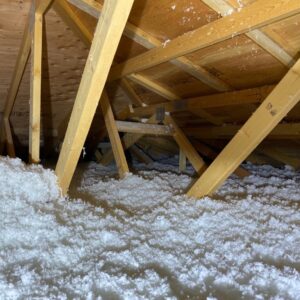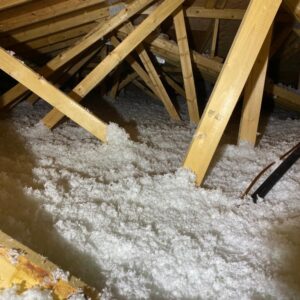Qualities of BLOWN-IN INSULATION
Blown-in insulation is mostly found in either a cellulose composition, or fibreglass. Quite an effective option in the attic and/or roof cavity, both products offer comparable R-value where installed. While the cellulose product is known to pry somewhat higher R-values, it also tends to settle after time. What’s more, each of the product compositions come with attributes but there is one most important thing that is installed at a professional level which will assure optimal long term performance.
Blown-in insulation is designed to be fire resistant. Cellulose is used to stop the spread of fire, while fibreglass is hard to ignite by nature . Fire resistance is a necessary feature in attc because of which , blown-in insulation is often suggested as a “top up” to existing insulation. As long as the installation space is dry and uncontaminated, the “top up” approach can do the work. It is a very cost effective installation for the attic by which R-value can be enhanced as well as the lifespan can be increased.
Benefits of BLOWN-IN INSULATION Services
Improving Energy Efficiency
Blown-in insulation can improve energy efficiency after the installation is completed. The product coverage is comprehensive in a vast space like the attic, as well as most cracks and crevices are filled properly.
Sound Dampening Qualities
Blown-in insulation can provide a level of sound dampening with a comprehensive installation. This may be beneficial to homeowners at the time of using adjacent areas to the attic as living space.
Quick Installation
With the right professional equipment, installation of blown-in insulation is time saving, particularly when it is compared with other instals . This makes for project savings and a cost effective installation.
Comprehensive Coverage
When it is installed expertly, blown-in insulation does a satisfactory job covering the attic space. Coverage is comprehensive like, Support cross beams, plumbing pipes, electrical wiring and all of the ductwork.
Seasonal Energy Savings
Effectively insulating the attic with blown-in insulation will prevent heated air and cooled air from escaping. This will reduce energy consumption as well as result in reduced utility costs.
Benefits of Blown-in Insulation
Over The he Years
Blown-in insulation offers enhanced energy efficiency throughout. It means that there will be a proper balance maintained in heating and cooling cycles and the HVAC system will perform in a better way.
Fast Installation
Blown-in insulation can be quickly and efficiently installed using specialised equipment as compared to traditional insulation methods that may require more time and labour to install. This means that homeowners and building managers can enjoy the advantages of improved energy efficiency and comfort in less time with minimal disruption to their daily routines.
Where can you install Blown-in Insulation?
Attic Insulation
Blown-in insulation is a best choice for insulating attics, which can be hard to access and may require specialised tools for installation. You can keep warm air inside during the winter and prevent hot air from entering during summer by choosing blown-in attic insulation which also reduces energy costs and makes your home more comfortable.
Wall Insulation
Blown-in Insulation can also be installed in walls, particularly in older homes that may not have sufficient insulation. This can be more helpful for reducing the heat loss as well as improving energy efficiency which leads to reducing the expenses of heating and cooling.
Floor Insulation
Especially in houses with crawl spaces or unfinished basements, blown-in insulation can be used to insulate floors which is more beneficial. This can be useful to reduce drafts and improve the overall energy efficiency of the home.
New Construction Insulation
For new Construction projects, blown-in insulation can be a great option because it is easy to install during the building process. It is also reducing the energy expenses and improving comfort by ensuring that the hoes or buildings are properly insulated from the starting point.
Commercial Building Insulation
Blown-in insulation is not just perfect for residential homes , but it can also be used to insulate commercial properties such as, offices, retail spaces, and warehouses. It is a cost effective way and also creates that type of environment where employees and customers can feel comfortable.
Soundproofing Insulation
In addition to its insulation properties, blown-in insulation can also be used for soundproofing purposes. You can reduce noise transfer between rooms by installing blown-in insulation in walls, floors, and ceilings in order to create a quieter, more peaceful living or working environment.








